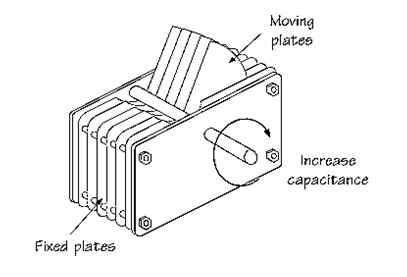A variable capacitor, also known as a tuning capacitor, is an electronic component that can adjust the capacitance value in a circuit. Capacitance is the ability of a capacitor to store electrical charge, and it is measured in farads.
Variable capacitor consists of two parallel conductive plates separated by a dielectric material, with one plate being fixed and the other adjustable by means of a movable arm. By changing the distance between the two plates, the capacitance value can be varied. Variable capacitors are commonly used in radio frequency (RF) circuits to tune the frequency of a signal and in other electronic circuits where a variable capacitance is required.

Features of Variable Capacitor
The key features of a variable capacitors are:
- Adjustable capacitance: The capacitance value can be varied by adjusting the distance between the plates.
- Range of capacitance: Variable capacitors come in a range of capacitance values, allowing for a variety of applications.
- Compact size: Variable capacitors are often small in size and can be easily integrated into electronic circuits.
- Precise tuning: Variable capacitors allow for precise tuning of frequency in radio frequency (RF) circuits.
- Durability: Variable capacitors are designed to withstand frequent adjustments and have a long lifespan.
- Low leakage current: Variable capacitors have a low leakage current, making them suitable for high-frequency applications.
Symbol of Variable Capacitor

Working of Variable Capacitor
The working of a variable capacitor is based on the principle of capacitance, which is the ability of a capacitor to store electrical charge. A capacitor consists of two parallel conductive plates separated by a dielectric material, such as air or plastic.

In a variable capacitor, one of the plates is fixed, while the other plate is adjustable by means of a movable arm or rotor. By moving the rotor, the distance between the two plates can be varied, changing the capacitance value.
When a voltage is applied to a capacitor, the plates become charged with opposite charges, with one plate being positively charged and the other negatively charged. The amount of charge stored on the plates depends on the capacitance value and the voltage applied.
In a variable capacitor, as the distance between the plates is increased, the capacitance value decreases, and as the distance between the plates is decreased, the capacitance value increases. This change in capacitance value allows the variable capacitor to be used for frequency tuning in radio frequency (RF) circuits and for other applications where a variable capacitance is required.
Types of Variable Capacitor
There are several types of variable capacitors, each with their own specific applications. Some of the most common types are:
Air Variable Capacitor
An air variable capacitor has two plates separated by air, and the distance between the plates is adjusted by a movable rotor. These capacitors are commonly used in radio frequency (RF) circuits and are known for their high precision and stability.
Ceramic Trimmer Capacitor
Ceramic trimmer capacitors are used in applications where high stability and precision are required. They are made of ceramic material and have a movable ceramic rotor that adjusts the distance between the plates.
Electrolytic Capacitor
An electrolytic capacitor consists of two plates separated by an electrolyte, and the distance between the plates is adjusted by a movable rotor. These capacitors are commonly used in audio circuits and are known for their high capacitance values.
Variable Tuning Capacitor
A variable tuning capacitor is a type of air variable capacitor that is specifically designed for use in radio frequency (RF) circuits. It has a high capacitance range and a precise tuning mechanism that allows for the tuning of different frequencies.
Multi-Turn Capacitor
A multi-turn capacitor is a type of variable capacitor that has multiple turns of the rotor. This allows for finer adjustment of the capacitance value, making it useful in applications where high precision is required.
Vacuum Variable Capacitor
A vacuum variable capacitor is a type of capacitor that uses a vacuum as the dielectric material. It is used in high-power applications and is known for its high voltage and current handling capabilities.
Applications of Variable Capacitor
Some common applications of variable capacitors are:
- Radio tuning circuits
- Oscillators
- Filters
- Voltage-controlled oscillators
- Audio tone controls
- Voltage regulators
- Antenna tuning.

